You are reading the older HTML site
Positive Feedback ISSUE
42march/april 2009
Audio Ramblings - a Fluttering of Feet
by Dave Clark
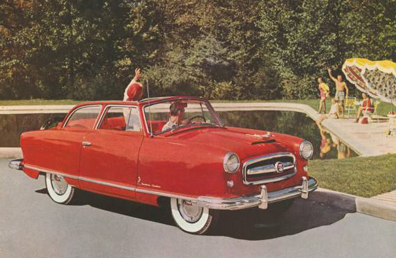
Reviewing feet or isolation devices has to be one of the most dreadful assignments for any reviewer to take on… and yet here I am assigning it to me! I mean, what I am taking on here is a survey, of sorts, of various feet and such that individually will alter to some degree what a component will sound like.
Yeah I said alter. Alter as in 'change' how the component relates to its surroundings and as such; how it will resonant (or not) thereby changing its sound. Some 'isolation' devices will do this drastically and some will do this not so drastically—that is their effects will be rather subtle in nature. Some 'isolation' devices will do this 'alteration' for the better and, well… some not so much for the better. All of them will do whatever they do to various degrees, and… note that I am saying 'isolation' as not all devices will totally isolate a component. Some couple and some decouple… some do both… and some do this to varying degrees. Some tune, some channel, and some do the shimmy-shake. But in the end, like I said earlier, they will all impart some degree of change to the sound by doing whatever it is that they do. The trick is finding what works with what, in how it is doing that thing that it is doing! For me at least the goal of any isolation device/footer is to add clarity or presence to the music. That is I want hear more of what is there… more light in the soundfield to sort things out and to open things up. And less of what is in the way of realizing this goal. Bigger, wider, deeper… more resolution. But not to the point of fatigue and going over the top. Got to maximize while keeping it in perspective.
Yeah… okay… you said with what? Now that's the issue. Got two, three, or four components? What works best (or better) with one component might not be the cat's meow with another… and vice versa. Got a lot of time to really tweak things? Uh … no? I am with 'ya there, so let's keep it simple. Try working with just one component and go from there. Once you know what an isolation device (or various devices) sounds like, that is, what it (they) do to the sound of a component or how they work together to do whatever… then using this with that becomes the word of the day with the rest of your system's components. Assuming of course you have a fixed bead on how something sounds. Got to establish a reference point first he says! But then again we are never really just listening to one component, but a complete 'system' in how all the components play with the others.
But wait one minute… what is it that you want? I mean what do you want from a component and isolation device? What sound are you looking to obtain through whatever is being placed under whatever component? I am not saying that one has to be necessarily unhappy or displeased with what one is hearing via a "naked' component—one that is sitting au natural on its own two… err four feet—but as I said above one can always push the performance or sound a bit further by addressing… attenuating… minimizing… maximizing… eliminating… taming …or say we 'tuning' some resonances or whatever is going on between a component and its surroundings to obtain some perceived beneficial effect.
That is, I love what I am hearing with my gear, but I wouldn't mind a bit more this and a bit less of that sort of thing. Obviously you like the sound you got but perhaps you wondering if you can push it a wee bit further down the road without losing what you love? Not out to make any big changes… just something more subtly better as opposed to a complete overhaul. If you want a complete overhaul… well, time to buy something different. Isolation devices should never make that much of a difference, but if they do, then you are heading in the wrong direction. Something is clearly wrong and it is time back way up and rethink your approach to making music!
So what do I have to play with?
From Composite Products, LLC Designs I had a CF-2010 platform (acrylic with CF-Cones w/pad) - $600 each and a CF-2010 Reference platform (acrylic with a carbon fiber layer on top and taller CF-Cones w/pad) - $1000 each, along with a selection of their various cones: the CF-Cone (carbon fiber anti-vibration cone) - $25 each, CF-Cone w/ Pad (anti-vibration carbon fiber cone with Sorbothane cushion) - $30 each, CF-Disk (1.15" diameter x .62" thick laminated carbon fiber) $20 CF-Support I (anti-vibration carbon fiber cone and Sorbothane ring) - $75 each, and the CF-Isolator (a carbon fiber cone with a carbon fiber disc and two types of Sorbothane in different thicknesses and damping properties) - $100 each.
What we have here from Composite Products is the use of carbon-fiber and Sorbothane (and Acrylic in the platforms) to decouple and dissipate resonances or vibrations that can hinder or color your component's performance.
From World Audio Distribution I had the Cold Ray 3 Ceramic Black - $350 (set 3), Cold Ray 4 Steel Silver (set 3), the SSC Flatbase Black Isolation Platform - $267, SSC Netpoint 100 - $135 (set 4), and the SSC Netpoint 300 - $160 (set 4).

The idea behind Cold Ray is quite different from most other decoupling devices, because it is not in fact a decoupling device, but rather a resonator. Cold Ray consists of three separate parts: a steel base cone, a bearing ball (which comes in either steel or ceramic), and a steel cover bell. The steel cover bell together with the bearing ball, serve as the resonators, greatly limiting the amount of resonance that can pass through Cold Ray.
The String Suspension Concepts' pucks utilize a pre-stressed web integrated into the sandwich construction of the Net point series. Outstanding improvements to sound are achieved through its elastic force and firmness. The Net point 100 has a felt plate on top and the Net point 300 is for the use with metal spikes.

From Black Ravioli I had 8 of the Ravioli Pads ($150 for 4) which are constructed of a number of layers of two differing materials held within a fabric enclosure. One material layer is a proprietary laminate that provides for a very efficient and fast energy conversion and the other layer provides segregation that contributes to coupling/de-coupling of the component and its surroundings.

From Marigo I have three of the TR Mystery Feet - $659. The TR feet are probably the tweaky-est I have had here and they do look the part. Being made from three layers of some composite-like material that is cut into a 'star-like' shape, along with various other materials used to hold the thing together, these are a result of Ron Hedrich's life-time of learning through his technical background in physics, research and development, and aerospace engineering.
I also have the latter (but not the latest) versions of the Townshend Audio 3D sinks. These are my reference and work wonderfully well in mitigating resonances and vibrations (both internal and external) from any component I have used them with—either my Cary SLP-05 preamp, the Cary 306 Professional SACD player, and the EMM CDSE/SA player. All have benefited to a great degree from being placed upon a Sink with minimal negative effects being realized—there are no perceived negatives to their use… sonically that is. But there is a caveat in one's use of the Sinks… they lose air over time and as such, that means that they will change the sound of a device 'sonically' over time as they become less effective in doing what they are doing. Yeah, one can pump to them to the right pressure when need be, but being a rubber bladder they are not immune to the limitations of a membrane. That is, they are not air tight. So over the course of a few weeks, as the air leaks out, the resonant frequency of the Sink changes, and so does their ability to address the optimal isolation of a component… the sound changes… slowly, but surely. Max knew this and the newest Sinks toss aside the rubber bladder for springs. Cool, they sound the same regardless. Nothing to fill… nothing to mess with. But the new Sinks cost a cool Cleveland! Uh… okay, that's a bit steep, but compared to what else is out there… well, maybe the new Sinks are not such a bad deal. (I have not tried the latest version of the Sinks, but people I trust report that they are way better than the older Sinks… well, maybe next time.) So I guess part of the reason for taking on this survey was to try something different in seeing if I could get the upsides of the Sinks without their downsides.
Also in house are the standard-bearer of isolation devices… the Black Diamond Racing #3 and #4 Pits ($55 each) along with the matching #3 and #4 Pucks ($60 for a set of 3). These have always worked wonders and are a staple in my house. What makes the BDR stuff so good is that they are reasonably priced, and they simply do what they do without imparting much if any sonic signature of their own into the mix. I do use BDR cones in conjunction with the Sorbothane feet that came attached to the Cary SLP-05 preamp and power supply. The cones are a perfect fit and my thinking is that of decoupling with a degree of absorption/dissipation… it works and when combined with a Sink… wunderbar!

Okay so what to try them under? Well I do have the Cary 306 Professional SACD player, but the player's feet have a rather tall-ish height (a good 1.5") that precludes it from being an easy candidate, though obviously I can try some items under the Cary… just not all of them. And besides the 306 is quite heavy at 40lbs, so not so sure I want to move it around all that much! The Cary SLP-05 preamp as I mentioned above has its integral Sorbothane feet in combo with the BDR cones and well… not easy to pry the BDR cones out of the Sorbothane's grasp. Once seated they ain't going to budge… so like the 306 I can try some of the items under the preamp, just not all. Besides, not so sure I want to be moving the preamp all that much… there goes an NOS Pope tube!
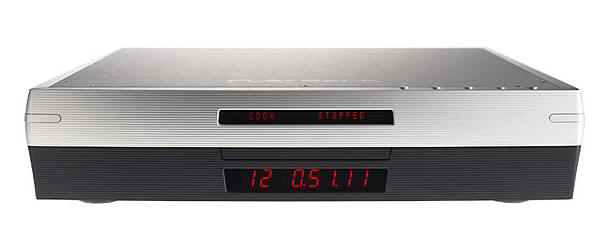
Oh… look what the cat (in my house that would be the dog) dragged in… the Playback Designs' MPS-5 player. Hey… and at only 29lbs that makes it a wee bit lighter than the 306… nice. And its own feet only are 3/8" high! But it ain't my reference, so… guess I got to spend a lot of time with such a wonderful playback device… oh darn! Remember what I suggested above… try a gaggle of feet under one component you know rather well to find out exactly what they are doing. After that, it should be easier to predict what they will do under a different component that you are also familiar with. (Note… the EMM is visiting a friend who is interested in pursuing that line of playback so it was not available at the time… would have been a nice candidate though!)
After an extended period of time to not only let the MPS-5 settle in but for me to become familiar with its sound (I am talking about a good 5-6 weeks of use as my player of choice, meaning it was fully broken in and I had a really good grasp of how it sounds au natural—and one should definitely read David R.'s review… he hit it squarely on the head), I learned this about the devices in house when used under the MPS-5 or either of the two Cary products when spacing/height allowed for their use…
In general terms, the Composite Products CF-2010 platform tends to turn the resolution knob up a few notches by opening up any of the components I tried them under in a way that is quite startling. One hears more of everything that one tends to want in the land of audiophiledom, and with minimal trade-offs. Yes, it does tend to 'lighten' things up a touch by drawing a bit of the lower registers away… or is there simply a spotlighting of the registers from the upper mids and up (this is especially so when combined with certain other products—see below)? Though that is hard to say as one could draw either conclusion; the music does have more sparkle or light, more 'information' but there is somewhat less bass weight… less oomph to the music. Meaning that the music is now just a tad drier or leaner; nothing to run home to mom about, but we did all hear this to varying degrees. Carol felt the music to be perhaps more 'brighter' with the CF-2010 than without. Others found the music to be simply more open and chock full of information that was not as readily apparent when heard from the components sans the platform.
The Composite Products CF-2010 Reference platform (shown below) brought the same results as the 'regular' platform, only it went even a few notches further sonically in terms of resolution and presence. On the other hand, the CF-2010 Reference had less impact on the lower registers in that there was less being taken away, though it did tighten up the lower register by removing a degree or two of boomy bloominess that robs the music of its flow and speed. Yeah the CF-2010 Reference was very nice… it is clearly a step up over the non-Reference platform (which is 'just' acrylic as opposed to the Reference's use of acrylic combined with the carbon-fiber layers on the top) in terms of overall musicality—as well as it should be considering the price increase and its addition of carbon-fiber. It is less 'bright' to use Carol's descriptor, but it still retains the sonic signature of acrylic: speed, clarity, presence, resolution … and neutrality; along with the added benefit of carbon-fiber's rigidity and solidity.
But when either of these were used under the MPS-5, it pushed the player's already stellar sonics a bit too far into the realm of being a bit overly over the top (say from the upper mids and up)… we all heard this tonal shift which bordered on becoming a bit fatiguing after extended listening sessions. Yeah, it is very impressive at first listen, but… well I am not so sure it is the way to go for the long haul. This combo was simply too much of a good thing.
On the other hand, when used with the Cary 306, which has slightly a fuller darker sound than the MPS-5 (as heard from the lower registers and up into the lower mids), it was a match made in heaven. Nice indeed this was in that we heard less of what one does not want to hear in terms of boom and bloom (interestingly enough, but the Cary sounded very nice before the CF-2010 Reference, but now it sounded even better) and more of what one does want to hear …natural resolution and clarity with no fatigue. With the Cary things were really cooking. Trying either platform under the Cary SLP-05 preamp was nice as well… also more resolved clarity and presence… less darkness and gloom, though not a dramatic shift in either direction—which is what one should want to hear… just making it a wee bit better we are! Nice indeed.
But forget trying either platform along with the Marigo TR Mystery Feet. The Mystery Feet remove any and all resonances that might make anything… I mean anything get in the way of your ability to hear what is what. That means that you get it all…. and I mean ALL. You want the truth… well with the Marigo TR Mystery Feet combined with the Composite Products CF-2010 Reference platform and the Playback Designs MPS-5… you might not be able to handle the truth. These feet are spectacular at how well they really really clean things up, but when combined with either platform it is simply too relenting… especially with the MPS-5. Ran solo they are truly killer devices, though they do work better musically under the Cary than the MPS-5. Combine the Feet with either platform and the resolution and detailing is way over the top; sibilant and bright are now the call of the day, though what one hears elsewhere in the realm of frequency clarity is quite amazing.
Now I realize that this is a matter or preference as I have had several people here who loved the TR/MPS-5 combo and others who winced at the clarity …too much they plead. I do recommend the Mystery Feet, but try them before you buy them… they do work as advertised though in some cases I found them simply too much of a good thing. I realize it is hard to say that as an audiophile… the TR Mystery Feet are way too open, offer way too much detail and presence, present way too big of a soundstage… and are way too taxing to my mind. While much of what they did was very enticing, they simply added too much etch and glare to certain frequencies on too much of my music… WAY too much of a good thing.
On the other hand, I
did find that moving them around mitigated to a great degree this blinding
clarity or presence while still relishing in their benefits. By placing one
front left of the tray, a second to the far right middle, and a third to the far
left rear, the MPS-5 sounded very nice indeed… but there still was a touch too
much etch or brightness, and well… tried with a Composite Products CF-Disk
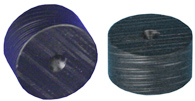 under each of the Marigo TR Feet I found that I was able to reduced this
annoyance to a considerable degree… this 'brightness' or hyped-presence. Cool
and quite inexpensive, the
Composite Products CF-Disks
worked wonders to warm things up. I tried them under various feet and cones and
in all cases they reduced to varying degrees any hardness or brightness that
detracted from extended periods of musical enjoyment. They appear to make a
decent interface between any cone/foot in question and, well… they work. Not
much else to say!
under each of the Marigo TR Feet I found that I was able to reduced this
annoyance to a considerable degree… this 'brightness' or hyped-presence. Cool
and quite inexpensive, the
Composite Products CF-Disks
worked wonders to warm things up. I tried them under various feet and cones and
in all cases they reduced to varying degrees any hardness or brightness that
detracted from extended periods of musical enjoyment. They appear to make a
decent interface between any cone/foot in question and, well… they work. Not
much else to say!
The Composite Products CF-Cone, CF-Cone w/Pad (below right) and CF-Support all had a 'solid' feel to them. They tended to shift the music in less dramatic ways as heard from either of the 2010 platforms; both in terms of gains or losses. Yeah, they work quite nicely and get out of the way, but they did not make any really significant changes to any of the components I tried them under—which is a good thing. They were simply rather subtle, though to varying degrees they were also equally effective in how they cleaned up the sonic tapestry from the mids and upward (providing a tad more resolution and clarity), though in doing so they also made the bass a bit fuller and rounder; especially so on the MPS-5 and way more so on the Cary 306—not a good thing. Simply put, the Cones and Support added a bit too much bloom or dullness (the Sorbothane perhaps?) resulting in a decrease of slam and clarity in the lower registers. Again, nothing to run home and cry about and certainly a nice touch if a component is a bit lean, though not the direction I wanted from the MPS-5 or the Cary 306.

The Composite Products CF-Isolator (above front) takes what either of the above Cones did and then went a few notches further. These were quite nice in how they brought a pleasant degree of clarity and presence without going too far in that direction; they also had just the right amount of solidity and tonal 'rightness' as well. Yet, these also brought on that bass bloom and lack of slam (or clarity or presence) to the lower end—it does combine both types of Sorbothane as used individually in the CF-Cone w/Pad and CF-Support as noted above so gee… makes sense. The bass was a touch slower and rounder… it was simply not as detailed or delineated as heard with other competing products under either component. So while the CF-Isolator appears to be their 'statement' footer, and while I liked what it did from the mids and up… I was not as enamored with what they did from the lower mids and down. A bit too soft and ill-defined down below and not something that I could live with when compared to the other products… especially the Marigo TRs and Cold Ray 3s which are both speed incarnate in how they portray the bottom-end. This issue was only really discernable when compared to these too speed/clarity demons… on their own the Composite Products are affordable winners—they work as advertised. Now for many this added warmth or bloom will be heard as a blessing… especially if your system leans towards the leaner end of things, so obviously this is more an issue of preference and component compatibility. Nice, very nice.

Cold Ray 3 Ceramics (above) are very nice in that they really do seem to do what Lars claims they do: clarity and presence are there in spades…as is the speed and pacing, which is really a head turner. The bass is a bit leaner but it is way faster… less boom and bloom being similar to that heard from the Composite Products, though not to the same degree. They are also a tad less warm and are certainly not as open or as ultimately resolving as the Marigo TR Mystery Feet. But then again the Marigos, when placed under the MPS-5, can be a bit too unrelenting in terms of clarity and presence, so it is all a matter of finding the right match.
Yeah, the Cold Ray 3 Ceramics work as advertised and they are easy to use; especially under the Cary 306. I liked that the component was as stable as need be (the Composite Products left me wondering if the player might fall as their height is a bit out of proportion to their diameter—that is they are rather tallish and skinny making them look more unstable than they really are—but we audiophiles are into looks!). I used the four as supplied and found that when set correctly the component had a slight degree of movement in any direction on the horizontal plane. As used with the Cary, the Cold Rays took the player several notches in the right direction with no discernable tradeoffs. The bass was cleaner, with a less fullness or bloat (though prior to the insertion of the Cold Rays I had always found the bass to be fantastic) allowing the Cary 306 to really open up and gain more speed and energy. The bass was now even better as was everything else!
When used with the MPS-5 there was an ever so sight metallic character along with a subtle shift away the player's warmth and overall richness of tone. A wee bit too clean and cold for me, but this is not a deal killer, just not what I am personally after in terms of overall musicality with the MPS-5. Then again, one could easily argue that the Cold Rays might just be revealing the true character of the MPS-5 or perhaps altering its resonant characteristic in a way that is not all that beguiling… or appreciable? No doubt. Another listener thought the the Cold Ray/MPS-5 combo to be right on… so go figure! Uh… different people like different things… or at the very least hear and appreciate things differently.
Having been acquainted with Lars and the Nordost boys for all these years, I fully expected to hear what I did from the Cold Rays. In many ways, the Cold Rays have that Nordost sound: clean and pure, speed and clarity, a bit leaner and lighter than the competition, and not one to be dark or warm, though still musically satisfying. Oh, and possessing of a big soundstage and being way dimensional. And add in that idea of energy and enthusiasm… yeah, those two words sum the Cold Rays up nicely… energy and enthusiasm. And Nordost too …just like Lars!
Now I will say that I have no idea if they do what they do because of their design—being resonant 'bell's' if you want—but they do work. And yes, I was expecting them to have a metallic quality to their 'sound' since they are after all metal. And lo and behold I heard that quality with the MPS-5 though not to the same degree with the Cary 306. I have experienced this affect with other metal isolation devices (the Aurios and Final Darumas for example) and though the Cold Rays did not present this quality to the same degree as they did it in now way detracted from their performance or my enjoyment of our music. Perhaps the use of the ceramic ball (I did not try the metal-balled version as another writer wanted to try those after hearing the benefits of the ceramic ones here) mitigates this to a great degree. Even so, the Cold Rays are quite nice indeed.
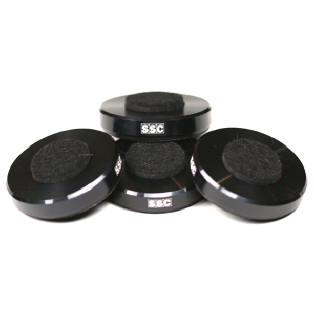
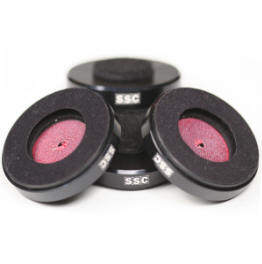
The SSC Flatbase Black Isolation Platform (shown below) and the SSC Netpoint 100 and the SSC Netpoint 300 (shown above) all produced rather subtle, though audibly similar, results. Music had a nice sense of liquidity and ease and they seemed to impart way less of 'themselves' into the mix. That is they did less to change a component's sonic signature than the other devices, but even so the music had more presence and such with them, than without. These are simple and easy to use and allowed the music to come through with minimal 'adverse' or gross alterations to the original tonality. Sure they did not 'brighten' things up in that their use did not result in substantial increases in clarity or presence—as heard to a greater degree with the other products—but then again they are way less costly than anything else here… so you get what you pay for. They do work…one just has to expect a bit less in terms of overall improvements. Nice concept and very affordable, consider these to be more of an entry into the realm of isolation. You will reap some very appreciable gains in terms of overall musicality… which is after all the goal!
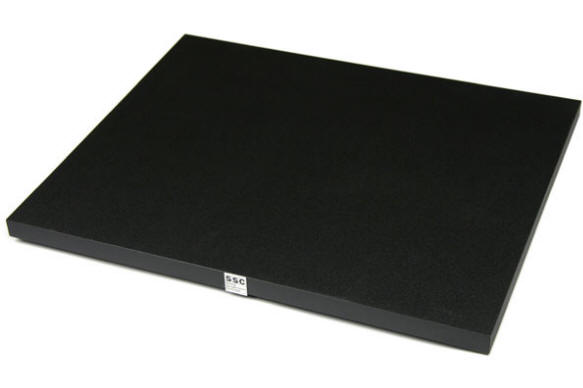
The Black Raviolis (shown below) are rather special in how they impart on the music a great sense of ease and natural 'flow'… nothing is rushed, nothing is spot lit… it is very organic and beguiling with a openness that lies within the music—not an openness that suggests 'bright' or that of an upward tonal shift. The Black Raviolis do more to remove issues or problems that obscure the music than to add or push anything onto the music in the sense of an increase in clarity or presence. The downside is that under either of the players the bass became less distinct or softer. There was simply less impact and resolution when compared to the other products, especially the Cold Rays, Marigos, and the BDR Cones. Each of these clearly did bass way better, but none of them could touch the Raviolis in terms of that organic natural quality which was imparted into the mix as the Raviolis were added under a component. This suggests that perhaps the Raviolis work their magic from the mids and up into the lower treble. The highs are airy, but they do not do the resolution or clarity/detail thing that the others do. Then again, like I said above, they also do not commit any real sins either. Nothing happens that would make one want to run away… no glare or clarity/presence to push things over the top. The Raviolis will draw you in for a nice relaxing musical time with your music of choice.

They are very nice and perhaps a perfect match for the CF-2010 Reference platform if one considers the combination of their organic ease with the Platform's presence and clarity. Black Ravioli does offer an extended line that features the Pad with a Corian 'risers'… now that looks interesting in that perhaps that one can get more of what the Composite platforms offer. I will have more on the Raviolis in a future article as there is a lot to try with these little pastas.
The Black Diamond Racing #3 and #4 Cones, along with #3 and #4 Pucks are well… heck they work and do so without causing a commotion that detracts from what they do do. Simple and elegant, the BDR Cones and Pucks do what I want them to do… get out of the way by not imparting a sonic signature of their own, allow for more music and all that entails to come through the speakers, and make the act of listening a joy to perform and not a chore. This is especially so under the MPS-5 player where they are a perfect match. They allowed for the player to move up a few notches in all the areas I wanted, while at the same time never going too far in nay one direction. That is they gave me clarity and presence without going over the top and becoming bight or excessive.
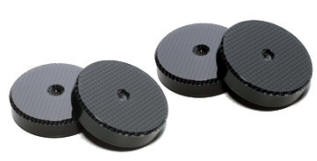
Even so, it would be nice if they went a wee bit further in the clarity department as heard from the Composite Product Platforms and then a wee bit further in the energy and enthusiasm as heard from the Cold Rays… and then a bit or two of that organic essence one gets from the Black Raviolis… but well… the BDRs do offer to a great degree those qualities… just not to the same extreme or level as those respective products. Yeah, but then again nor do they possess any of the characteristics that I found to be a possible negative. Not a negative in the sense that they are doing anything necessarily wrong, but a negative in the sense that some resonance or musical quality was energized in a way that detracted from my listening pleasure. Or one that at the very least was not beneficial to how either of the components under question preformed. So I guess the BDR are doing okay. They work as advertised and come as close to what the Townshend Sinks do without making any errors along the way. It is nice being able to mix and match the #3 and #4 products to get the sound just right.
While the #3s are a warmer and the #4s are more detailed, the differences are not huge… more heard as a subtle shift tonally or like a mild seasoning. But cool just the same.
All the products being scrutinized here do what they do quite well… they work as advertised. The question is which one works best with your gear to meet your needs, wants, or preferences? All are highly recommended… but you got to try before you buy to find that magic. YMWV....
Black Ravioli http://blackravioli.co.uk/ and http://www.globeaudiomkt.com/
Cold Ray and SSC http://www.worldaudiodistribution.com
Composite Products http://www.composite.com
